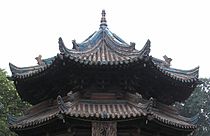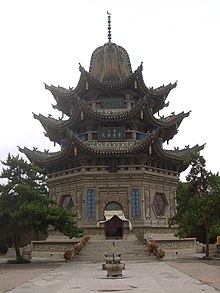Ma Laichi
Tampilan
| Bagian dari serial tentang:
Islam di Tiongkok |
|---|
 |
|
|
Ma Laichi (1681? – 1766?[1]), (Hanzi sederhana: 马来迟; Hanzi tradisional: 馬來遲; Pinyin: Mǎ Láichí; Wade–Giles: Ma Lai-chih) juga dikenal sebagai Abu 'l-Futūh Ma Laichi, adalah seorang imam Sufi Tiongkok. Ia membawa gerakan Khufiyya ke Tiongkok dan menciptakan menhuan (tarekat Sufi) Huasi, sebuah tarekat Naqshbandi (نقشبندية,納克什班迪) terawal dan paling berpengaruh dalam sejarah Muslim Tiongkok.[2][3]

Kesusastraan
[sunting | sunting sumber]- Gladney, Dru C. (1996). Muslim Chinese: ethnic nationalism in the People's Republic. Volume 149 of Harvard East Asian monographs (edisi ke-2). Harvard Univ Asia Center. ISBN 0-674-59497-5. (First edition appeared in 1991).
- Lipman, Jonathan Neaman (1998). Familiar strangers: a history of Muslims in Northwest China. Hong Kong University Press. ISBN 962-209-468-6.
- Weismann, Itzchak (2007). The Naqshbandiyya: orthodoxy and activism in a worldwide Sufi tradition. Volume 8 of Routledge Sufi series. Routledge. ISBN 978-0-415-32243-0.
Referensi
[sunting | sunting sumber]Wikimedia Commons memiliki media mengenai Huasi Gongbei.
- ^ As it is often the case with the 17th and 18th-century Hui Sufi figures, the chronology of Ma Laichi's life is not set firmly. Gladney (1996) (p. 47) gives no birth year, and 1766 as the death year; Weismann (2007) (p. 83), gives no birth year, and 1753 as the death year. Lipman (1998) does not give exact years for birth and death, and emphasizes differences between different historians' chronologies (p. 67); however, adding up lengths of time intervals in his biographical account implies that Ma would be close to 48 in 1728. The Great Chinese Encyclopedia (中国大百科全书, vol. 14 宗教 (Religion), p. 255) gives 1681-1766.
- ^ Gladney (1996), pp. 47-48
- ^ Lipman (1998), p. 65-67
Bagian dari sebuah serial tentang Islam Sufisme dan Tarekat |
|---|
|
|
